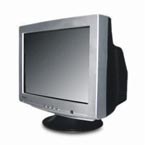Calibration for pros: Colour-neutral reproduction on the PC monitor
 Munich - When it comes to colours being displayed on computer monitors, many computer users cannot be blamed for being confused. After all, the white on the screen is not really white. Monitor technology itself often disrupts the neutral depiction of colours: imperfect circuitry or tubes may cause the image to have a reddish tinge or the colours to appear too cold. The best chance you have of setting up your monitor with professional precision is to calibrate it, says Andreas Roth from Prad, a consumer portal for monitors and TVs.
Munich - When it comes to colours being displayed on computer monitors, many computer users cannot be blamed for being confused. After all, the white on the screen is not really white. Monitor technology itself often disrupts the neutral depiction of colours: imperfect circuitry or tubes may cause the image to have a reddish tinge or the colours to appear too cold. The best chance you have of setting up your monitor with professional precision is to calibrate it, says Andreas Roth from Prad, a consumer portal for monitors and TVs.
There are two type of calibrations: hardware-based and software-based. "Users calibrate the hardware directly on the monitor itself," Roth says. Most monitors do not offer this feature, however. The only option, then, is to use colour management software and check the settings on the graphics card. In both cases, a colourimeter is used to measure the current colour value of the display.
"Hardware calibration is better because the RGB correction curve on the graphic card is not affected," Roth explains. That provides more correct colour gradients. Monitors that can be calibrated at the hardware level tend to be very expensive and tend to be oriented toward professional users. "It's helpful for anyone who needs consistent colour reproduction - layout specialists, graphic arts, and professional photographers," explains Bernd Weser-Krell from Munich-based PC-Welt magazine. "That said, amateur photographers also discover the benefits of colour fidelity on the monitor and during printing," he adds.
Users who do not calibrate end up adjusting the settings to reflect their subjective perception, Roth says. When that happens, reproductions do not reflect the true colours. The base settings can generally be made right on the monitor, explains Horst Strobender, a product manager at Samsung.
"The best thing is for the user to reset the display settings once he or she gets the computer home and then adjust it to individual needs," Strobender says. Monitors on the retail selling floor are generally set to be extremely bright and with very high contrast.
Many settings like contrast and brightness can be adjusted using the monitor menus, Weser-Krell says. Some equipment allows the user to adjust the individual colours of the RGB channels. Most consumer models use sRGB as the lowest common denominator for the colour space. If the device or graphics card does not specify a colour space, then Windows defaults to sRGB.
Calibration should be repeated on a regular basis. "Modern TFT monitors change the colour reproduction over the course of their service lives, so calibration needs to be performed on a relatively regular basis." For heavily used monitors the calibration should be undertaken every four to six weeks. (dpa)